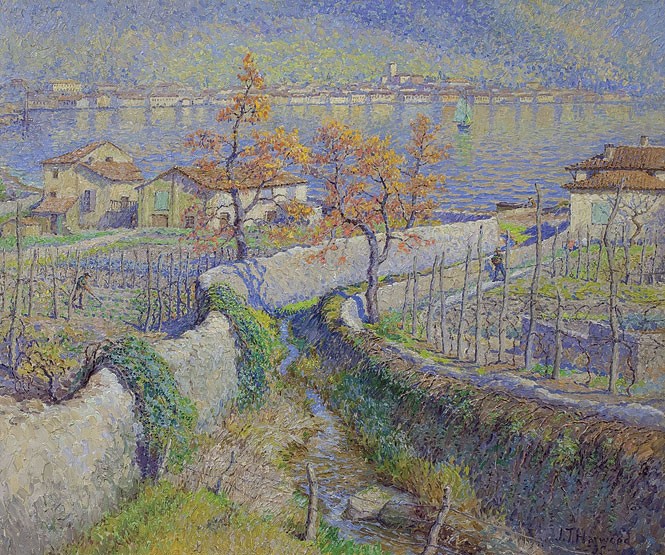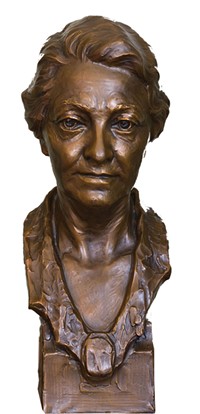Devotees and Their Shrines
Centennial exhibit celebrates legacy of Utah art advocate Alice Merrill Horne
By Brian Staker @stakerizedThis year marks a number of historical milestones: the 45th anniversary of the first moon landing, and a century since a events leading up to World War I. In 1914, Utah had been a state for less than 20 years, and we were still figuring out our place in the nation.
We were also still figuring out our artistic identity. Alice Merrill Horne was only the second female legislator in the state, but she would prove to have an influence that is still felt today. Horne wrote and sponsored legislation to create the Utah Art Institute—later becoming the Utah Arts Council and now known as the Utah Division of Arts & Museums, the oldest state-sponsored arts agency in the country.
Horne acknowledged "the challenge of artists making a living in Utah, and worked to help artists in that challenge much like the institution she started continues to do today," says Jim Glenn, who manages the state's fine-art collection.
She also wrote a book titled Devotees and Their Shrines: A Handbook of Utah Art—published in 1914 by the Deseret News—to serve as a guide to local art and artists in the early 20th century. The Division of Arts & Museums is commemorating the book's centennial with an exhibit of artists mentioned in the book at Alice Gallery in the Glendinning Mansion on South Temple. The 19 works in the exhibition serve as a visual essay on the foundations of Utah art.
Horne described the act of making and looking at art as being akin to a spiritual endeavor, but she also thought that art is an activity in which anyone can partake. She believed in a democratic approach to aesthetic pleasure, and began the introductory chapter of her book by saying, "Poverty is a poor excuse for ugliness, and wealth can never get rich enough to purchase good taste." She even went so far as to say, "We are all artists to a degree."
Her own aesthetic was idealized, and she begins the volume with illustrations and discussions of the Venus de Milo, Leonardo's "Last Supper" and the Mona Lisa, as well as a few observations on looking at art for enjoyment first, then criticism.
She then begins the book in earnest, charting the beginnings of the artistic impulse in crafts such as those practiced by Native Americans, then finding ideals locally in the design of buildings made for Brigham Young. She notes that the Deseret Academy of Arts, founded in 1863, was the first art school in the West, and then discusses a number of Utah artists.
The stories of these artists paint a picture of early Utah history. George Martin Ottinger, later an art instructor at the University of Utah, arrived by ox cart, ran away to sea as a boy, and painted the first scenic backdrop for the Salt Lake Theatre. His oil painting "The Children of the Sun, Manco Capa and Maina Ocllo" (1890) depicts figures from Inca mythology. The sun god Capa and his bride are radiant, illuminated by Ottinger's use of light.
Many of these artists used nature as their subject, as Utah artists often have done, depicting another kind of "shrine." George Wesley Browning's watercolor "Fall Mountain Scene" (1941) captures a sense of placidity in the natural world. Several works devote themselves to local figures, like Myra Sawyer's "Helen Kimball" (early 1900s). Sawyer, one of the first local female artists to gain recognition, studied in France and Spain, copying works of Velasquez.
Mahonri Macintosh Young's "The Blacksmith" (1906) utilizes some Rembrant-esque chiaroscuro. This descendent of Brigham Young shows in his figures the weight and physicality of sculpture, his main art form; he's better known for the "This Is The Place" and Seagull monuments in Salt Lake City.
The artworks on display are also an odyssey through the various styles of Utah artists. Horne's book cites the early work of James Taylor Harwood, whom she notes was one of the first students from Utah to be accepted into the Beaux Arts in Paris. Harwood's "Vintage of Northern Italy" (1938) showcases the impressionistic brushstrokes of Van Gogh, a style he began working in well after the publication of the book.
The keen eyes of Horne herself will be on display as well, in the form of a 1941 bronze bust by Avard Fairbanks, created as a tribute to her devotion to local art and promoting it.An art gallery itself is a kind of shrine, and Horne was well aware of that. The exhibit marks the devotion of the state of Utah to its artistic heritage, and also provides inspiration to artists working in the present.
A copy of the book Devotees and Their Shrines is at Alice Gallery for browsing, and can also be read online at Archive.org.
DEVOTEES AND THEIR SHRINES
Alice Gallery
617 E. South Temple, 801-236-7555
Through Sept. 12
Free
VisualArtsUtah.org
More by Brian Staker
-
Live Music Picks: April 12-18
Judas Priest, The Residents, Clownvis Presley, The Breeders and more.
- Apr 11, 2018
-
Loving the Alienation
Helios Creed and Chrome continue making iconoclastic music for outcasts.
- Mar 28, 2018
-
Live Music Picks: March 22-28
U.S. Girls, Ed Schrader’s Music Beat, Hell’s Belles, Columbia Jones and more.
- Mar 21, 2018
- More »




